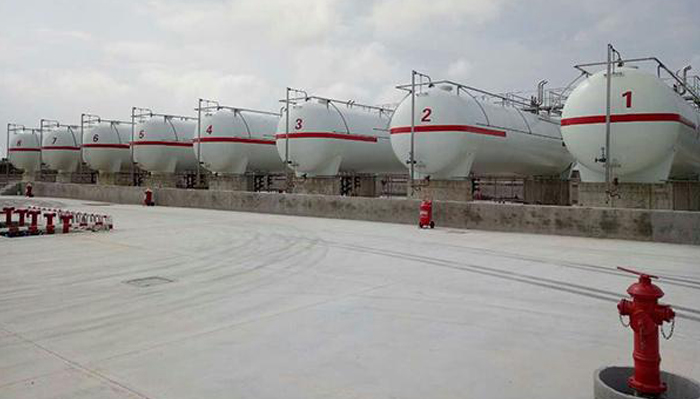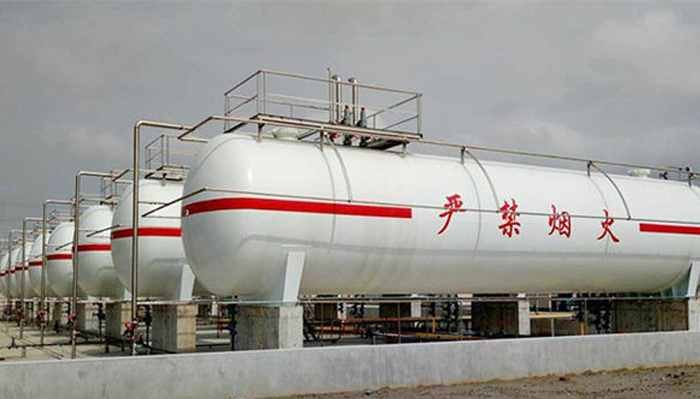Product Category
Hazards of LPG Storage Tank Leaks
Date: Dec 30, 2019

LPG has the characteristics of being flammable, explosive, poisonous and suffocating. Its gaseous state is heavier than air, and it is lighter than water when it is liquid, and its volume expands more than 250 times when it changes from liquid to gaseous. Therefore, the leakage of LPG storage tanks is inestimable. Therefore, in order to prevent and control the leakage of LPG storage tanks, we must first understand and master the characteristics and knowledge of LPG.
LPG has very strong volatility, ignition point is lower than -60 ℃, has flammable and explosive characteristics, the minimum ignition energy is 0.2 ~ 0.3mJ, once encountering electrical sparks, friction generated static electricity and other ignition sources, extremely Prone to combustion and explosion accidents.
When liquefied petroleum gas leaks, 1m³of liquefied petroleum gas can be converted into a gaseous liquefied petroleum gas of 250 ~ 300 m³. The explosion limit of liquefied petroleum gas is calculated according to the approximate value of 1.5% ~ 9.5%. Medium, it will become an explosive gas of 3000 ~ 15000m³.
LPG has very strong volatility, ignition point is lower than -60 ℃, has flammable and explosive characteristics, the minimum ignition energy is 0.2 ~ 0.3mJ, once encountering electrical sparks, friction generated static electricity and other ignition sources, extremely Prone to combustion and explosion accidents.
When liquefied petroleum gas leaks, 1m³of liquefied petroleum gas can be converted into a gaseous liquefied petroleum gas of 250 ~ 300 m³. The explosion limit of liquefied petroleum gas is calculated according to the approximate value of 1.5% ~ 9.5%. Medium, it will become an explosive gas of 3000 ~ 15000m³.

Explosive gas formed by the leakage of liquefied petroleum gas causes chemical explosion due to electrical sparks, friction, static electricity and other ignition sources. Its explosive power is 4 to 10 times the equivalent of TNT explosives, and the detonation speed can reach 2000 to 3000 m / s. Due to the large calorific value of liquefied petroleum gas, the calorific value of 1m³ is 6 times that of coal gas, and the flame temperature is as high as 1800 °C. Therefore, after the explosion of liquefied petroleum gas, it will quickly ignite all combustibles in the explosion area, resulting in large-scale combustion, causing major damage and casualties.
The liquefied petroleum gas in the liquefied petroleum gas storage tank maintains a vapor pressure equilibrium under a certain temperature and pressure conditions. When the tank body bursts suddenly, the liquid in the tank will cause a fierce vapor explosion due to a sharp phase change. When the storage tank equipment or accessories catch fire due to leakage, both themselves and the adjacent equipment will be flame-baked; when the internal liquid is heated to expand and the pressure exceeds the strength that the storage tank can withstand, it will rupture, and the internal medium will expand instantly, High speed releases internal energy, triggering a physical vapor explosion. The sprayed liquid quickly vaporized and was ignited by the fire source, a fireball appeared, and strong thermal radiation was generated. If it is not immediately ignited, the sprayed liquefied gas is mixed with air to form a flammable gas cloud. A secondary chemical explosion occurs near the fire source, and its power and damage are much greater than physical explosions.
The liquefied petroleum gas in the liquefied petroleum gas storage tank maintains a vapor pressure equilibrium under a certain temperature and pressure conditions. When the tank body bursts suddenly, the liquid in the tank will cause a fierce vapor explosion due to a sharp phase change. When the storage tank equipment or accessories catch fire due to leakage, both themselves and the adjacent equipment will be flame-baked; when the internal liquid is heated to expand and the pressure exceeds the strength that the storage tank can withstand, it will rupture, and the internal medium will expand instantly, High speed releases internal energy, triggering a physical vapor explosion. The sprayed liquid quickly vaporized and was ignited by the fire source, a fireball appeared, and strong thermal radiation was generated. If it is not immediately ignited, the sprayed liquefied gas is mixed with air to form a flammable gas cloud. A secondary chemical explosion occurs near the fire source, and its power and damage are much greater than physical explosions.
Next article:
Send Your Inquiry
We not only provide a good product, but also provide high quality service. If you are interested in our products,
you can contact us in the following ways.
you can contact us in the following ways.















































































































